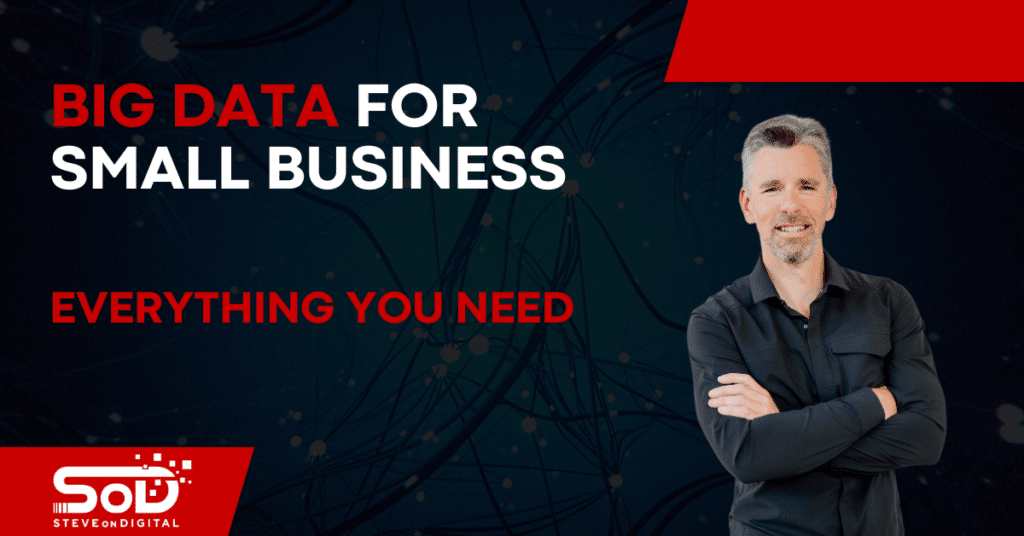As a digital transformation specialist with a deep background in project management and a passion for empowering small and midsize businesses (SMBs), I’ve witnessed firsthand the transformative power of big data.
In today’s digital age, leveraging big data can provide invaluable data and meaningful insights that fundamentally change how small businesses operate and compete.
What Is Big Data?
Big data refers to extremely large data sets that may be analyzed computationally to reveal patterns, trends, and associations, especially relating to human behavior and interactions.
Three key characteristics define big data: volume, variety, and velocity.
- Volume: Big data involves enormous volumes of data. For small businesses, this could mean data collected from customer interactions, sales data, or even social media data.
- Variety: This refers to the different types of data available, from structured data like sales figures to unstructured data like customer feedback.
- Velocity: The speed at which data is generated and processed. Real-time insights can help businesses respond quickly to customer needs and market trends.
Importance Of Big Data Analytics
In the digital age, big data analytics has become crucial for small and midsize businesses to gain insights and drive business decisions.
Using analytics tools like Google Analytics or advanced Customer Relationship Management (CRM) systems, businesses can parse through vast amounts of data to extract valuable information that informs strategic decisions.
This ability to make data-driven insights enhances competitiveness and efficiency, providing a significant edge over those relying on manual methods.
Decoding Big Data
Big Data Vs. Small Data
- Big Data: Encompasses the vast amount of data collected through various digital platforms and sensors, offering deep insights into customer behavior, market dynamics, and operational efficiency.
- Small Data: Deals with data that is smaller in size but still critical. It’s often used to inform immediate decisions and can be analyzed more straightforwardly.
For most businesses, especially small and midsize businesses, the challenge lies in moving from data collection to extracting actionable insights.
Big data provides a comprehensive view, while small data helps in quick decision making.
Understanding Data Types
- Structured Data: This is organized data that can be seamlessly entered, stored, and analyzed. Financial data and sales data are typical examples, often stored in traditional databases.
- Unstructured Data: This type of data is unorganized and may be more challenging to manage but holds a wealth of insights. Social media content, images, and video content from marketing campaigns are examples of unstructured data.
Getting Started With Big Data In Small Businesses
Identifying Key Data Needs
Every small business should start its big data journey by identifying key data needs.
Customer data (from CRM systems or customer feedback), sales data (from point-of-sale systems or e-commerce analytics), and financial data (from accounting software) are foundational for informed decisions.
Tools And Technologies For Data Analytics
For small businesses, the array of available analytics tools can be daunting.
However, starting with accessible platforms like Google Analytics is advisable, which provides insights into online customer behavior and marketing effectiveness.
As needs grow, more sophisticated analytics solutions from specialized analytics companies can be incorporated to delve deeper into big data for small business, offering more granified marketing analytics and predictive business analytics accessible to small and midsize businesses.
Driving Decisions Through Data
As the owner of SteveOnDigital (and other businesses) and an advocate for digital transformation in small and midsize businesses, I’ve seen how big data can be a game changer.
Let’s delve into how businesses can transform raw data into actionable insights and make swift, informed decisions.
Transforming Data Into Actionable Insights And Informed Decisions
Data analysis is not just about gathering information; it’s about turning that information into actionable insights that can drive strategic business decisions.
Here’s how I apply this in my operations and how you can too:
- Data-driven insights: Begin by collecting relevant data from various sources such as customer feedback, sales data, and social media platforms. Using analytics tools, this data is then processed to identify trends and patterns.
- Decision making: The insights gained are used to make informed decisions. For example, analyzing customer data helps in tailoring marketing strategies that better address the needs and preferences of the audience, ultimately impacting marketing ROI positively.
Real-Time Insights
In the fast-paced digital age, the ability to make quick decisions is crucial.
Big data enables real-time insights, allowing businesses to react instantly to market changes and customer needs.
- Customer preferences and market trends: Leveraging big data tools like Google Analytics and advanced CRM systems, small businesses can track real-time data on customer behavior and market conditions, adjusting their strategies accordingly.
- Production line adjustments: On the production side, real-time data from the production line can be used to make quick adjustments, enhancing efficiency and reducing downtime.
Customer Insights And Engagement
Engaging effectively with customers and securing their loyalty involves understanding and anticipating their needs.
Here’s how big data plays a crucial role in enhancing customer retention and personalizing marketing messages.
Analyzing Customer Behavior And Preferences Through Data
By deeply analyzing the data collected from various touchpoints, businesses can gain a thorough understanding of their customers:
- Social media data and customer feedback: These sources are rich in insights about what customers think about your products and what they expect next. Analyzing this data helps tailor products and services to better meet customer expectations.
- Predictive analytics: Tools that offer predictive business analytics accessible to small businesses can forecast future buying behaviors based on past data, allowing businesses to be proactive rather than reactive.
Enhancing Customer Retention And Personalizing Marketing Messages With Predictive Analytics
Predictive analytics not only helps in understanding what the customer wants today but also predicts future trends, enabling personalized marketing that resonates more effectively with the audience.
- Marketing messages and campaigns: Using data to craft personalized messages that speak directly to the needs and desires of the customer can significantly enhance engagement and loyalty.
- Customer retention strategies: Predictive models can identify at-risk customers, allowing businesses to implement retention strategies proactively to keep them engaged and satisfied.
Optimizing Operations And Efficiency With Big Data
Big data is instrumental in optimizing business operations, making them more efficient and responsive to market demands.

Streamlining Operations
Effective data use can streamline operations significantly:
- Production line optimization: Big data analytics can identify inefficiencies in the production line, allowing for adjustments that reduce waste and increase output.
- Inventory management: Data analysis helps predict demand more accurately, ensuring that inventory levels are kept optimal, reducing storage costs and minimizing stock-outs.
Identifying Hidden Patterns And Gaining Insights To Improve Efficiency
One of the most valuable aspects of big data is its ability to reveal hidden patterns that are not apparent to human analysts.
- Hidden patterns in customer data: By analyzing all the data collected, businesses can uncover unexpected purchasing habits or preferences that can lead to new product ideas or marketing strategies.
- Operational insights: Big data acts as a catalyst that brings to light inefficiencies and opportunities in business operations, helping leaders make more strategic decisions that lead to a competitive edge.
Financial Management
As the owner of SteveOnDigital, I’ve always emphasized the power of data in transforming various aspects of business, and financial management is no exception.
Here’s how small and midsize businesses can harness big data for smarter financial planning.
Leveraging Financial Data For Accurate Budgeting And Forecasting
Accurate budgeting and forecasting are crucial for the health of any business, especially small businesses where resources are limited.
Here’s how leveraging financial data helps:
- Historical data analysis: By examining past financial data, businesses can forecast future trends more accurately. This involves analyzing sales data, expense data, and market trends.
- Predictive analytics: This tool allows businesses to use past financial data to predict future financial conditions. This can include predicting cash flow shortages, which helps in making informed decisions about where to allocate resources.
Predictive Business Analytics
Predictive business analytics accessible to small businesses play a crucial role in financial planning:
- Risk assessment: By analyzing financial data, predictive analytics can identify potential risks in investments and expenditures, allowing businesses to avoid costly mistakes.
- Resource allocation: It helps in determining the most effective ways to allocate resources to maximize revenue and reduce costs, leading to more strategic business decisions.
Empowering Your Workforce
Data-driven approaches are transforming human resources, from recruitment to employee satisfaction, proving that big data is not just about customer insights but also about enhancing workforce productivity.
Enhancing Recruitment And Performance With Data-Driven Insights
The recruitment process can be significantly improved with big data analytics:
- Talent acquisition: Analyzing data from recruitment processes and employee performance helps identify the best sources for talent and the qualities that contribute to employee success.
- Performance analysis: Big data tools can help monitor and analyze employee performance continuously, providing insights that help in making informed decisions about training needs and performance incentives.
Leveraging Human Resources Data To Boost Employee Satisfaction And Productivity
Employee satisfaction is key to productivity, and here’s how big data helps:
- Employee feedback: Using data collected from surveys and daily interactions, HR departments can gain insights into employee satisfaction and overall morale.
- Customized training programs: Data analytics can help tailor training programs to the needs of individual employees or departments, enhancing skill levels and productivity.
Marketing With Precision
Marketing strategies backed by big data lead to more precision in targeting and higher efficiency in results.
Here’s how I apply these strategies in my business.
Developing Targeted Marketing Strategies Using Customer And Market Data
Targeted marketing strategies are essential for maximizing engagement and conversions:
- Customer segmentation: Big data allows for precise segmentation of customer bases into specific demographics based on purchasing habits, customer feedback, and online behavior. This segmentation helps in creating more tailored marketing messages.
- Market analysis: Analyzing big data sets helps understand market trends and customer behavior, enabling businesses to tailor their marketing strategies to market demands.
Measuring And Optimizing Marketing ROI With Data Analytics
The ultimate goal of any marketing campaign is to achieve a high return on investment (ROI), and data analytics is critical in measuring and optimizing these efforts:
- Marketing campaigns analysis: Data analytics provide insights into the effectiveness of different marketing campaigns, helping businesses understand what works and what doesn’t.
- Cost-effectiveness: By analyzing the data from past marketing efforts, businesses can allocate budgets more effectively, focusing on strategies that offer the highest ROI.
Security And Privacy
As a business owner at SteveOnDigital, I know too well that managing sensitive business and customer information with utmost security is crucial.
Here’s what small businesses should focus on to safeguard their data effectively.
Best Practices For Data Security In Handling Sensitive Business And Customer Information
Effective data security is foundational for any business, especially when handling sensitive information.
Here are some best practices:
- Data encryption: Encrypting all the data ensures that even if data is intercepted, it remains unreadable to unauthorized users.
- Regular audits: Conduct regular security audits and vulnerability assessments to identify and mitigate potential security gaps.
- Employee training: Since human error can lead to security breaches, training employees on best security practices and recognizing phishing attempts is essential.
Compliance And Privacy Laws
Navigating compliance and privacy laws is a critical aspect of managing business data:
- Understanding GDPR and other privacy laws: Small businesses must be aware of and comply with relevant privacy laws like GDPR, which regulate how data should be handled and protected.
- Implementing privacy policies: Developing and enforcing clear privacy policies that comply with these laws helps in managing customer expectations and legal requirements.
Building A Sustainable Big Data Strategy
Developing a sustainable big data strategy is key to long-term success.

Here’s a guide to creating a strategy that aligns with your business goals.
Step-By-Step Guide To Developing A Big Data Strategy For Long-Term Success
A strategic approach to big data can provide a significant competitive edge:
- Define your business objectives: Clearly identify what you want to achieve with big data, whether it’s improving customer retention, increasing operational efficiency, or driving sales.
- Data collection and management: Decide what types of data are most valuable for your objectives, and establish processes for collecting, storing, and managing this data.
| Step | Action Item | Purpose |
| 1. Define Objectives | Determine what you want to achieve with big data. | Ensures all efforts are aligned with business goals. |
| 2. Collect Data | Decide what data to collect and how to manage it. | Gathers the necessary information for analysis. |
| 3. Choose Tools | Select appropriate analytics tools. | Employs the right technology to analyze collected data effectively. |
| 4. Implement Strategy | Apply insights to business operations. | Uses data-driven insights to improve business processes and decision making. |
| 5. Monitor and Adapt | Continuously assess the strategy’s effectiveness and make adjustments. | Keeps the strategy relevant and effective in changing business environments. |
Choosing The Right Analytics Tools And Solutions To Support Business Goals
Selecting the right tools is crucial for a successful big data strategy:
- Analytics tools selection: Choose tools that match your specific needs. For example, Google Analytics for web traffic analysis or more specialized tools for advanced data analysis.
- Integration with existing systems: Ensure the analytics tools integrate well with your existing systems to streamline operations and maximize the value of your data.
| Tool | Use Case | Ideal For |
| Google Analytics | Website traffic analysis and consumer behavior. | Small businesses seeking to enhance online visibility and marketing effectiveness. |
| Advanced CRM Systems | Managing customer relationships and sales data. | Midsize businesses looking to deepen customer engagement and streamline sales processes. |
| Predictive Analytics Software | Forecasting and risk assessment. | Businesses wanting to leverage data for future planning and decision making. |
The Future Of Big Data For Small Businesses
Big data is continuously evolving, and staying ahead of the curve is essential for small businesses. Here’s what the future looks like and how to prepare for it.
Emerging Trends
The future of big data includes exciting technological advancements:
- Artificial intelligence and machine learning: These technologies are becoming more accessible and can provide small businesses with the ability to make more informed decisions by identifying patterns and predicting trends.
- Mobile devices: As mobile usage continues to grow, big data strategies will increasingly focus on leveraging data collected from mobile devices to enhance customer experiences and engagement.
Preparing For The Future
Staying ahead in big data utilization involves continuous learning and adaptation:
- Continuous learning: Keep abreast of the latest technologies and trends in big data. Attending webinars, workshops, and conferences can provide valuable insights.
- Experimentation: Small businesses should experiment with new tools and technologies on a small scale before fully integrating them into their operations to minimize risk.
Conclusion
As we wrap up this extensive discussion on big data for small business, it’s important to reflect on how transformative this journey can be.
I’m Steve Johnston, and through my platform, SteveOnDigital, I’ve experienced the significant impact big data can have on small businesses.
Let’s recap the benefits and encourage a shift toward a more data-driven culture.
Recap Of The Benefits Of Big Data For Small Businesses
Big data is not just a buzzword; it’s a transformative tool that can drive small businesses towards remarkable growth.
Here are some of the key benefits we’ve explored:
- Informed Decision Making: Leveraging big data helps businesses make more informed decisions by providing actionable insights and meaningful insights. This is crucial in optimizing operations and strategy.
- Enhanced Customer Insights: Big data analytics enable businesses to understand their customers better, from behavior to preferences, leading to improved customer retention and personalized marketing strategies.
- Operational Efficiency: By analyzing all the data, from production lines to customer feedback, small businesses can find hidden patterns that help streamline operations and reduce costs.
- Competitive Edge: In the digital age, having real-time insights and predictive analytics at your disposal can set you a step ahead of the competition.
| Benefit | Description |
| Informed Decision Making | Utilizes actionable and meaningful insights from data to optimize business strategies and operations. |
| Enhanced Customer Insights | Gathers detailed information on customer behavior and preferences to improve service and marketing. |
| Operational Efficiency | Identifies inefficiencies and areas for cost reduction through data analysis of operational processes. |
| Competitive Edge | Provides real-time insights and predictive analytics, keeping businesses a step ahead of competitors. |
Encouragement To Embrace A Data-Driven Culture For Continuous Improvement
Adopting a data-driven culture is essential for any business looking to thrive in today’s economy.
Here’s how small businesses can cultivate this culture:
- Commitment from Leadership: As a leader, your commitment to a data-driven approach will inspire your team. Show by example how leveraging data can lead to better business outcomes.
- Invest in the Right Tools: While it may seem daunting, investing in analytics tools and training your team to use them can demystify data and make it accessible. Tools like Google Analytics or more specialized analytics solutions can provide invaluable data to all levels of your organization.
- Continuous Learning and Adaptation: The landscape of big data is ever-evolving. Encourage continuous learning and experimentation within your team. This not only keeps your strategies fresh but also encourages innovation within your team.
- Culture of Curiosity and Experimentation: Foster a workplace environment where questions and experimentation are encouraged. This can lead to new insights and ideas that propel your business forward.
In conclusion, big data for small business is not just about handling large volumes of information but about understanding and using that information to make better business decisions, connect with customers more effectively, and streamline operations to compete more robustly in the market.
At SteveOnDigital, I’ve leveraged these principles to not only advance my business but also to help other small businesses understand the importance of a data-driven approach.
Embracing big data is embracing the future. Start small, think big, and scale fast.
Here’s to making more data-driven decisions and witnessing the growth and success they can bring to your business!

